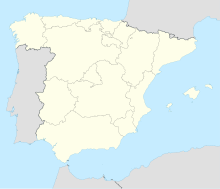Cueva Antón
Coordinates: 38 ° 3 ′ 51.8 " N , 1 ° 29 ′ 47.2" W.
The Cueva Antón half-cave is a paleoanthropological and archaeological site in the Murcia region of south-west Spain . The cave is located around 60 kilometers from the Mediterranean port city of Cartagena inland in the area of the municipality of Mula . It was washed out by the Río Mula and served as a dwelling cave for the Neanderthals in the Middle Paleolithic . The cave became internationally known in 2010 after a clam shell at least 43,000 years old was discovered there, to which orange pigment adhered. The pigment discovery was interpreted as evidence that the mussel shell had been used “in an aesthetic and probably symbolic” way. The find from the Cueva Antón was published together with similar finds from the Cueva de los Aviones ; they were described as the first such pieces of jewelery to be discovered in Europe by Neanderthals. The settlement of the Iberian Peninsula by modern humans ( Homo sapiens ) did not take place until several thousand years after the found object was made from the Cueva Antón.
cave
The rock in the cave consists of limestone , the origin of which was dated to the Eocene (around 50 to 40 million years ago). The water of the Río Mula created - as a result of erosion - a 25 to 30 meter high precipice, at the base of which the river also washed out a spacious hollow. For the first time in 1991, during excavations, evidence of an early human presence was discovered in a four-meter-thick layer of sediment. During renewed excavations in 2007 and 2008, a colored mussel shell was discovered. The dating of the find layer referred to an era a few thousand years before the arrival of Homo sapiens .
Find
The discovered flat shell of a large pilgrim mussel shows a hole in the area of the vertebra, the origin of which is unclear. What is certain, however, is that the shell was perforated before it was deposited in the cave , as there is an artificial orange discoloration on the inside of the hole.
The pigment consists of a mixture of yellowish goethite and reddish hematite and was applied to the outside of the mussel shell. The inside of the bowl, which is naturally reddish in color, was not treated with dyes. According to the researchers, the nature of the paint application does not provide any indication that the bowl could have been used for the production or storage of coloring materials; they therefore interpreted the clamshell as "body decoration".
Web links
- regmurcia.com Brief description (with pictures) of Cueva Antón (in Spanish)
- arqueomurcia.com (PDF; 693 kB) El yacimiento Musteriense de Cueva Antón (Mula, Murcia). In: Memorias de Arqueología, 1995. Scientific description of the cave and the stone tools found in it (in Spanish)
swell
- João Zilhão et al .: Symbolic use of marine shells and mineral pigments by Iberian Neandertals. In: PNAS . Volume 107, No. 3, 2010, pp. 1023-1028, doi : 10.1073 / pnas.0914088107
- João Zilhão et al .: Symbolic use of marine shells and mineral pigments by Iberian Neandertals. Supporting information. Available online at pnas.org (PDF) since January 11, 2010
Individual evidence
-
↑ João Zilhão et al .: Symbolic use of marine shells and mineral pigments by Iberian Neandertals. In: PNAS . Volume 107, No. 3, 2010, pp. 1023-1028, doi : 10.1073 / pnas.0914088107
An article on heise.de (“Big brain and more intelligent than thought”) from January 11, 2010 contains two images from PNAS; the lower one (colored one) shows the find from the Cueva Antón: on the left the natural coloring of the inside, on the right - mirrored - the orange colored outside. - ↑ Michael Balter: Neandertal Jewelry Shows Their Symbolic Smarts. In: Science . Volume 327, 2010, pp. 255 f., Doi : 10.1126 / science.327.5963.255
